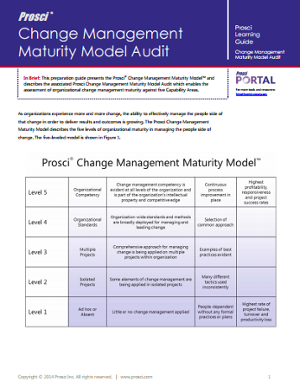Change is inevitable and in an environment where the frequency at which it is being demanded is on the rise; achieving a high level of enterprise change management competency is essential to the deployment of successful change.
Building organisational change management capabilities is often an ongoing process of adoption, and as various aptitudes emerge, organisations can be seen to display characteristics of distinguished maturity levels.
Based on benchmarking research, Prosci, a global leader in change management, developed a Change Management Maturity Model which enables an organisation to assess change management maturity, and thus visualise the progressive journey to effective change management. Considering particular areas within an organisation the level an organisation has achieved can be measured. The following 5 levels reveal the predominant characteristics at each stage; with increasing attention and management given to the people side of change.
Level 1: Absent or Ad Hoc
An organisation displaying this level of maturity is not aware of change management, and its application is perhaps only considered when employee resistance is putting the success of a project in jeopardy.
Organisations with Level 1 maturity will consider change management as a reaction to an existing project and very rarely integrate it with project management from the initial stages. It is often the case that employees in these organisations will react to change with resistance, which is heightened by the fact many will be informed of the immiment changes through the grapevine. It is common that there are minimal levels of communication surrounding the project delivery process. The leaders delivering a project of change often receive little support and sponsorship from executive levels and are not equipped with the skills and toolset to coach their employees through the process.
Level 2: Isolated Projects
Organisations able to display level 2 maturity capabilities will see elements of change management across isolated areas and projects within the organisation.
It is often the case that organisations within level 2 will apply change management in response to a negative event and while there are elements of communication and planning, there is little sponsorship or training. The projects delivered in this type of organisation will also see a great deal of variation in the approach of change management practices across projects within the organisation as its application is sporadic.
Level 3: Multiple Projects
With a maturity level of 3, the beginnings of a structured change management process is evident, however its reach throughout the organisation is often localised to particular teams or departments.
At this point an organisation will see multiple projects using a structured change management process, perhaps with slight variances, and a system of sharing knowledge and experiences between teams will be established. While the frequency of its application is increasing, there are no organisational standards or requirements. The adoption of change management practices also become more evident in senior management levels as a growing level of sponsorship, training and tools become available for increased levels of leadership, which can then be conveyed to front line employees.
Level 4: Organisational Standards
This level sees the adoption of a more unified approach to organsiational change management capabilities as well as the implementation of organisational standards. This means that a change management approach is incorporated into the beginning stages of a project including the planning phases.
At this maturity stage an organisation will see an enterprise wide acknowledgement of change management and its importance in project success; along with a greater level of access to tools and training for executives and project leaders, whilst managers and supervisors have received formal training. Not only this but specific individuals, groups or administrative positions have been dedicated to providing support and building employee skill sets in this area. Organisations with this level of maturity have not yet reached 100% adoption but are in the process of developing these processes and skills, company-wide.
Level 5: Organisational Competency
As the highest maturity level, organisations at this stage have been able to incorporate change management competency into their skill set.
Executives of a level 5 organisation will have made effective change management an explicitly strategic goal of an organisation. With the utmost level of sponsorship and buy-in from all management and leadership levels, change management is widely understood by all employees and its importance to project success is widely recognised. By providing extensive training to all levels of the organisation, change management is able to develop into a fully integrated feature that is largely inseparable from initiatives enabling the ongoing collection of data for the implementation of continuous improvement.
Progressing through the stages in the Prosci levels of change management maturity enables an organisation to make improvements in the ways in which it delivers change. The desire for a greater maturity level is growing as the correlation between the successful management of the people side of change and the ultimate success of projects becomes increasingly more recognisable.
Would you like to learn more about the five levels of change management assessment?Access your free copy of Prosci's Change Management Maturity Model Audit to delve deeper into the five levels and gain an insight into the steps you can utilise to progress your organisation into the higher levels of change management maturity.




